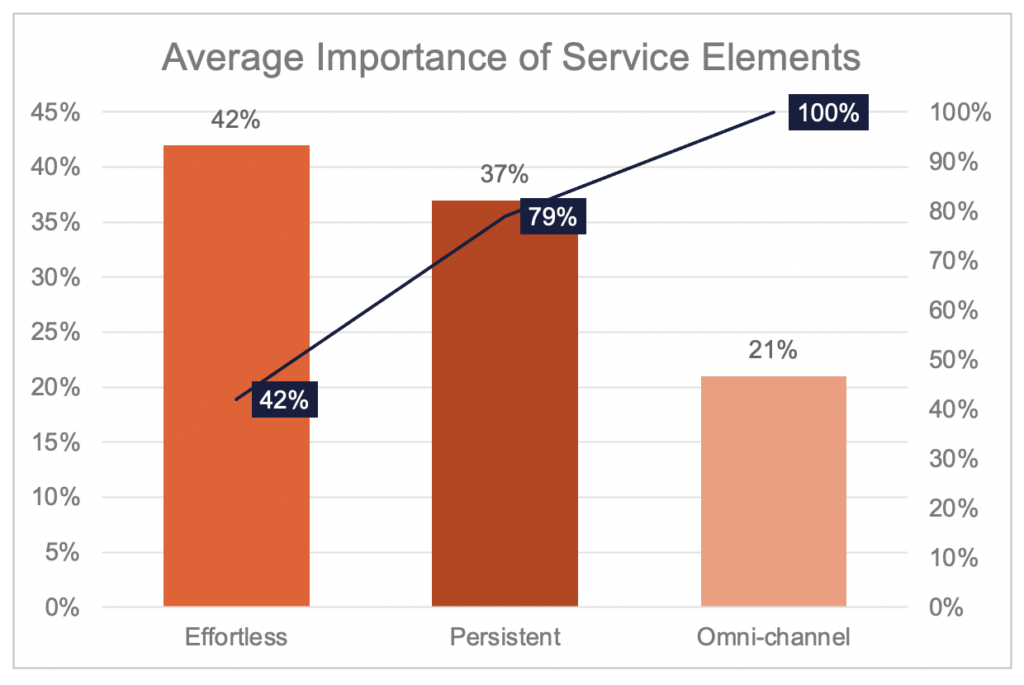Customer Service and Support (CSS) organizations must differentiate on the customer experience to maintain customer loyalty and improve retention. As a CSS leader with limited resources, you need to make strategic tradeoffs in service design. By researching the customer’s perception of service value, you can understand which service elements to invest in – and which to scale back.
Most CSS organizations have some form of a Voice of the Customer (VOC) program in place – usually transactional surveys. At the conclusion of a service interaction, the customer receives a survey so the company can measure customer satisfaction (CSAT) with the transaction.
While these surveys are an important data point, they typically have a narrow focus. The customer rates a specific service interaction, the channel used, and the outcome. Aggregate stats are used to benchmark the organization’s performance, and individual results are used to coach agents on improvement opportunities.
Transactional surveys are important for monitoring and improving existing service channels, but don’t provide the level of insight needed to design truly differentiated support experiences. They measure satisfaction for individual interactions, but can’t explore the connected sum of interactions or explore future possibilities.
At the TSIA Interact 2020 conference, I shared a three-phase research approach that CSS leaders can use to understand the customer’s perception of service value. This methodology won the 2020 North American Customer Centricity Award for “Customer Insight and Feedback VOC.”
This rapid Voice of Customer research project illuminates how customers think and feel about their service experiences, so you can design support services that customers actually value.
1. Identify Target Customers
The first step is to identify Target Customers. These are the customers you will focus on for research. Be specific about “who” you want to design support services for, before you focus on the “what.”
Your products were created to meet a customer’s need or solve a customer’s problem. Identify the specific kind of customer that the product was designed for. For example, a car service targeting business travelers would identify their ideal business clients, not families or tourists who happened to use their service too.
Enlist the help of cross-functional partners in Marketing and Sales. They should know exactly the kind of customers they are targeting for acquisition.
You can also use revenue as a guide. Many B2B companies find that the Pareto principle applies – 80% of their revenue comes from 20% of their customers. Those 20% should be the Target Customers.
The Target Customer may be an archetype, like “techie hobbyists,” in the B2C world, or specific customers (“XYZ Corp.”) in B2B. Think of Target Customers as pools of users, from which you will select specific people to interview.
When you design support services for the Target Customer, you ensure CSS makes the greatest impact on customer loyalty and company growth. The customers that fall outside of the target segment may also benefit, but beware of making changes that serve these ancillary customers at the expense of the target customers.
2. Interview Extreme Users
Once you’ve identified the Target Customers, the next step is to interview Extreme Users within those Target Customers.
To define an “extreme user,” imagine mapping usage to a bell curve. The Extreme Users fall on either end. The frequent consumers of customer support services on the right, and the infrequent users on the left – those who almost never contact support.
It’s important to learn from both perspectives. The frequent users have figured out how to best navigate the intricacies of the support offering, while the infrequent users will be the ones who have figured out how to self serve, discovered how to exist without service, or given up out of frustration.
Once you have identified extreme users, conduct Customer Experience Interviews. The goal of these interviews is to understand customers as whole people, with needs, wants, opinions, schedules, jobs, ideas, ambitions, and everything else that makes us human.
Expect the interviews to take about 2 hours. In the pre-pandemic world, my preference was to conduct the interviews in person, on the customer’s home turf. Being on their home turf allows the customer to feel more relaxed and comfortable, and allows you to step into their world and experience it first hand.
Interviewing customers is a skill, and it’s probably not well developed in the CSS organization. While we talk to customers all day long about their issues, these conversations are focused on issue resolution.
The customer experience interview is not about problem-solving, but learning about value in the eyes of your customer.
In the interviews, ask questions about:
- Outcomes – What are the customer’s goals when accessing support services, and how successful is the customer in achieving those goals?
- Emotions – How does the customer feel when interacting with support services?
- Channels – How does the customer prefer to interact with support services, if at all? What is their attitude toward self-service, email, phone, web, live agent chat, and virtual agents?
- Amenities – What non-essential extras create value in the eyes of the customer?
As you interview customers, themes will emerge. These themes become Service Elements – a new dialect for how you think about support services and message the change in your organization.
Define each Service Element in aspirational, easy-to-understand language. For example:
- Persistent: Interactions with support are part of an ongoing conversation, not individual transactions.
- Effortless: Interacting with support is easy and hassle-free.
- Omni-channel: I can interact with support on my issue in whatever way is most convenient for me at that moment.
Refine the themes as you learn from customers throughout the interview process. Customers will speak to the themes in different words and stories, but you can use a tool like 5 Why’s to analyze root causes. Compare and contrast how different customers prioritize the themes. One customer may highly value Omni-channel support, but another may place more value on a Persistent relationship.
As you complete the interview phase, you’ll be developing a rich understanding of customers and their motivations, needs, expectations, and frustrations with support interactions. You will have poignant stories and a new vocabulary to describe service. Before you share these insights with the organization, take one final step to validate these learnings across the broader customer base.
3. Validate Service Elements
The customer interviews will provide rich qualitative data and anecdotes, and you will have formed some opinions about what are the next steps for designing support services. You may have identified new channels to engage with customers, or low-value channels to eliminate or scale back.
The final step in the customer research is to validate your learnings by surveying the customer base.
In this step you will prove that what’s valuable to the Extreme Users on either end of the bell curve is also valuable to the users in the center, and quantitatively rank the service elements in order of value to the customer.
Construct a conjoint analysis survey using the Service Elements as the conjoint attributes. Within each attribute, write examples of different degrees of service for the conjoint levels.
Expanding on the Service Element examples above:
| Attribute | Level 1 | Level 2 |
|---|---|---|
| Persistent | Interacting with support feels like separate transactions. I often have to “start over” explaining my situation when I have a new issue or request. | Interacting with support feels like an ongoing conversation. They remember me, my preferences, and my current projects. |
| Effortless | I get the outcome I want when contacting support, but it often takes some work on my part. | Interacting with support is easy and hassle-free. They even anticipate my needs to prevent future issues. |
| Omni-channel | I have limited options when contacting support. I wish I could IM or chat instead of calling on the phone. | Support is available whether I want to chat, use the web, email, or call on the phone. I can even switch channels and pick up where I left off. |
In this example, obviously every customer wants Level 2 in every attribute. The magic of conjoint analysis is that it creates imaginary service offerings from pseudo-random mixes of different levels and forces the respondent to choose between these offerings. By forcing a series of preference choices, the survey can statistically say that one attribute is more valued than another.
After getting enough survey responses for a statistically significant sample, you will have a qualitative ranking of the Service Elements. The conjoint analysis will show which Service Elements are most important, and the relative importance of one element to another.

All Service Elements are important to customers, but not equally so. In the fictional example above, an Effortless experience was twice as important to customers as an Omni-channel experience. The company needs to deliver all three to get an A+ grade from customers, but the greatest opportunities are in reducing customer effort. With limited resources, this CSS organization should focus on effort, rather that introduce a new service channel. This analysis allows you to make strategic tradeoffs in service design.
In addition to the relative importance of the Service Elements, the conjoint analysis results will quantify the utility of the levels within each attribute. This becomes especially insightful if you have attributes with more than two levels.
From Insight to Action
After concluding this research, you will understand what customers value most in support experiences. This insight is unique to your customers and you now have the qualitative and quantitative data needed to differentiate these experiences from the competition.
With the insights from this rapid VOC research, you can spring into action. Design support services that deliver the most value to the customer. Scale back in low-value service offerings, and redirect the investment toward the outcomes, experiences, channels, and amenities that will differentiate your brand’s customer support experience.
